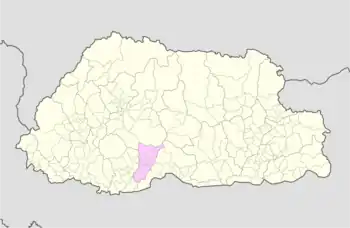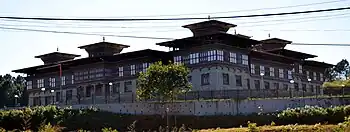Tsirang District
Tsirang
རྩི་རང་རྫོང་ཁག | |
|---|---|
District | |
| Tsirang Dzongkhag | |
 Map of Tsirang District in Bhutan | |
| Country | Bhutan |
| Headquarters | Damphu |
| Area | |
| • Total | 639 km2 (247 sq mi) |
| Population (2017) | |
| • Total | 22,376 |
| • Density | 35/km2 (91/sq mi) |
| Time zone | UTC+6 (BTT) |
| HDI (2019) | 0.629[1] medium · 8th |
| Website | www |
Tsirang District (Dzongkha: རྩི་རང་རྫོང་ཁག་; Wylie: Rtsi-rang rdzong-khag; previously (Chirang), is one of the 20 dzongkhags (districts) of Bhutan. The administrative center of the district is Damphu.

Tsirang is noted for its gentle slopes and mild climates. The dzongkhag is also noted for its rich biodiversity; however, it is one of the few dzongkhags without a protected area. One of Bhutan's longest rivers, the Punatsang Chhu or Sankosh river flows through the district. It is the main district where the Lhotshampa resides. It has many beautiful places such as Rigsum Pemai Dumra, Pemachoeling Heritage Forest, Tsirang Namgyel Chholing Dratshang, and Nye.[2]
Languages
The dominant language in Tsirang is Nepali, but it can be partially different from those spoken in Nepal, spoken by the heterogeneous Lhotshampa like Magar, Tamang, Gurung, Limbu, Rai, etc. In the north of Tsirang, Dzongkha, the national language, is also spoken.
Geography
Tsirang covers a total area of 639 sq km.[4] The northernmost reaches of Tsirang District (the gewogs of Phutenchhu and Sergithang) lie within Jigme Singye Wangchuck National Park, one of the protected areas of Bhutan.[5][3]
See also
References
- "Sub-national HDI - Area Database - Global Data Lab". hdi.globaldatalab.org. Retrieved 2018-09-13.
- "Tsirang Tourism | Tsirang Travel Guide & Best Time to Visit". Bhutan Tourism. Retrieved 2021-03-19.
- "Chiwogs in Tsirang" (PDF). Election Commission, Government of Bhutan. 2011. Retrieved 2011-07-28.
- Facts about Bhutan The Land of the Thunder Dragon.
- "Parks of Bhutan". Bhutan Trust Fund for Environmental Conservation online. Bhutan Trust Fund. Archived from the original on 2011-07-02. Retrieved 2011-03-26.